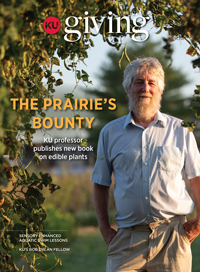KU Giving Magazine
Cultivating Innovation
Valerie Gieler
KU research contributes to the Jayhawk experience and the world
Learning is at the core of human existence — and for good reason. We would not survive long without the ability to figure out how to navigate the world. Most of us spend time discovering how to do things to improve our lives, whether it’s how to make a favorite meal from scratch, fix a broken appliance or identify a bird visiting the feeder.
Researchers go even further in the quest for knowledge to develop new treatments, technologies, approaches, creative works and other advancements that benefit our communities, society and the planet. The University of Kansas has a storied history of impactful research, scholarship and creative activity across a range of disciplines, consistent with its role as a major research university and a member of the Association of American Universities (AAU).
“At KU, research and scholarship are woven into the fabric of our institutional identity,” said Simon Atkinson, vice chancellor for research. “Sustaining this legacy requires ongoing investment in administrative and physical infrastructure supporting research activity, as well as an inclusive, collaborative environment that attracts and cultivates productive researchers and scholars.”
This focus on the research infrastructure and environment is important across all campuses, including the medical center. According to the Association of American Medical Colleges (AAMC), medical schools and teaching hospitals save millions of lives. “Academic medical centers such as the University of Kansas Medical Center are the highlight of a community in terms of the highest levels of care and innovation,” said Matthias Salathe, M.D., KU Medical Center interim vice chancellor for research. “What differentiates us is research — in all the basic sciences, translational sciences and clinical sciences. Investing in research is investing in the health of our community.”
Research Themes
“We are committed to supporting research, scholarship and creative activity across the entire university,” Atkinson said. The university has identified five research themes to address global challenges and build on current expertise: Development Across the Lifespan; Earth, Energy & Environment; Human Experience in the Digital Age; Molecules & Medicines; and Safety & Security. The strategic research themes represent a combination of KU’s existing strengths and emerging areas of excellence that align with both federal funding priorities for research and development and societal needs in Kansas and beyond.
Some examples of KU achievements in these areas include:
- A bestselling book, Origin: A Genetic History of the Americas, telling the story of the first people to populate the areas.
- The University of Kansas Cancer Center applying for National Cancer Institute comprehensive designation, the highest level available.
- Engineering researchers designing course modules to train students in building and maintaining more secure computer hardware.
- A reusable, at-home COVID-19 testing device developed on campus moving closer to being widely available.
- The National Science Foundation awarding a $4 million grant to improve how plastics are manufactured and recycled.
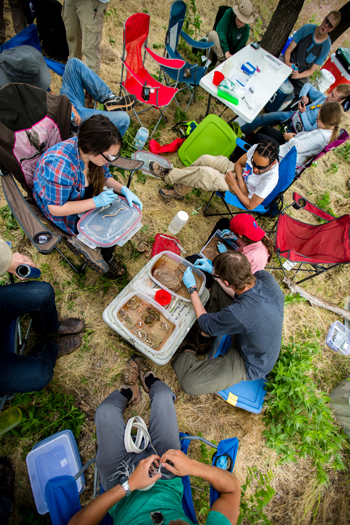
SITE WORK: Students in a summer field herpetology class visit the Alexander Ranch in Barber County, Kan., to learn how to conduct field surveys.
Photo by Meg Kumin / University of Kansas
Photo by Meg Kumin / University of Kansas
Impact and Reach
It is difficult to quantify the broad benefits KU innovation and discovery have on our world, but some recent results show direct impact. In 2021, more than $292 million in externally funded research was conducted at KU. This research supported the salaries of nearly 4,000 people and provided $50.7 million in spending with Kansas companies, fueling the local economy. About 32% of research-funded employees were students and about 20% were faculty.
KU’s research-related economic impact extends beyond these numbers reported by the Institute for Research on Innovation and Science. KU technologies have been part of launching 43 active startup companies, and 25 of those are in Kansas. Through the university’s relationship with and proximity to KU Innovation Park, researchers help attract businesses to the area. The park includes 62 companies and accounts for more than 500 private-sector jobs.
Private Partnerships
Continuing a high level of research success is only possible with the help of private support. Philanthropy can help researchers develop and test ideas to make them more competitive for large federal grants. It also helps fill gaps when the university identifies an important area of inquiry that may not have a dedicated funding source.
“Private funding is important for creating facilities that top researchers need to retain their position as leaders in their fields,” Atkinson said. “This includes labs and high-end instruments, but also making objects in museum collections available to scholars worldwide through online-access platforms or having the technical capability to showcase works created by writers or composers.”
Philanthropy can make research experiences accessible to more faculty members and students by providing grants and awards. It also supports research professorships and helps recognize Jayhawks who are already making research contributions. Unrestricted support from donors to KU Endowment allowed the university to provide 49 undergraduate students with $1,000 research awards to work on projects with mentors and recognize 12 faculty researchers for their contributions.
Endowed funds also support programs like Emerging Scholars, which provides research experiences for low-income students during their first year at KU. Students get paid to work as a research assistant and to participate in professional development workshops. Funding also supports graduate students who mentor the scholars.
“Students have a positive influence on research,” Atkinson said. “They ask questions no one else has asked and drive discovery in new directions. We also know research experiences are one of the ‘high-impact’ practices that can be transformative for students, building confidence and connections, as well as opening new doors to previously unimagined futures.”
At KU Medical Center, involving area high school students is one way of fostering the next generation of investigators. “The faculty and students enjoy giving high school students the opportunity to see what research is all about to get them thinking what a career in that space would be like,” Salathe said.
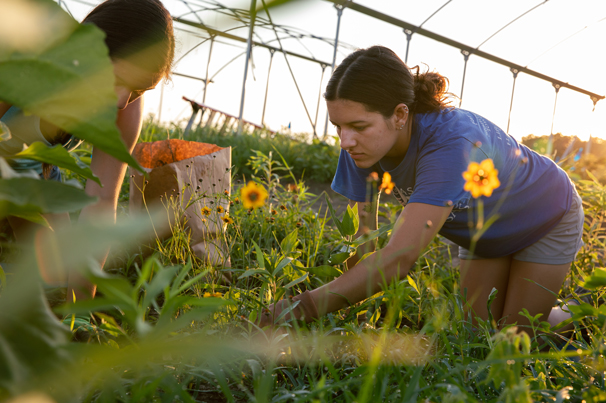
Meg Kumin / University of Kansas
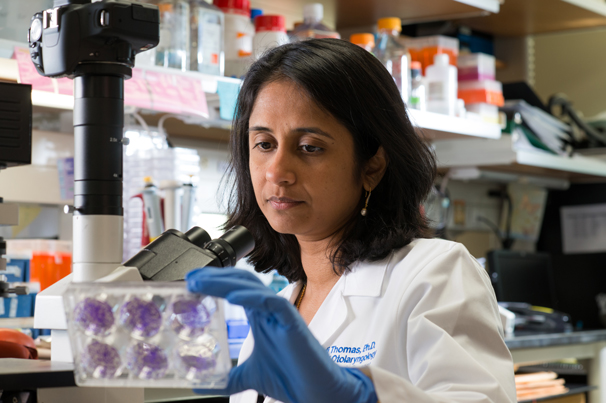
Mark McDonald
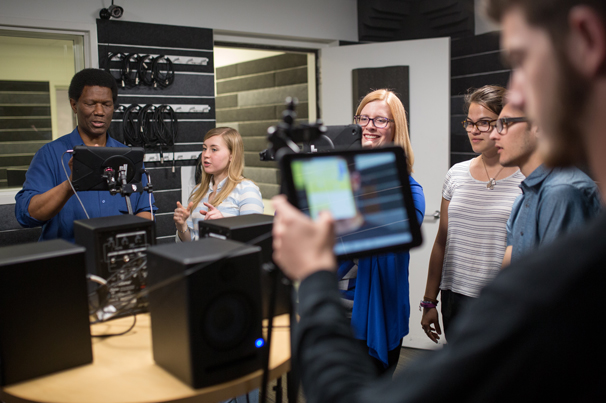
Meg Kumin / University of Kansas
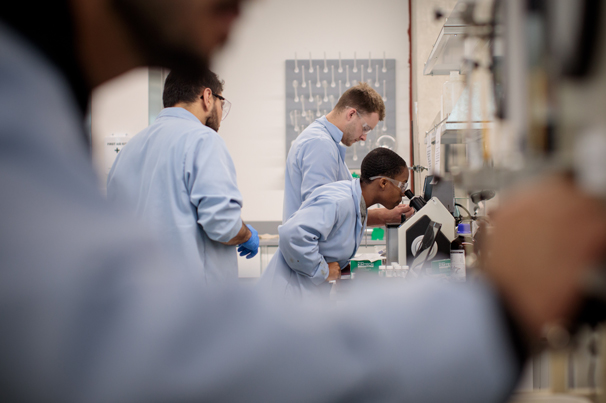
Meg Kumin / University of Kansas

Meg Kumin / University of Kansas

